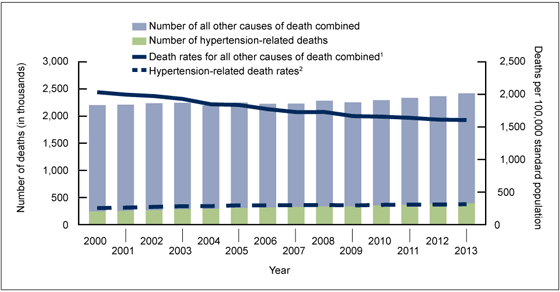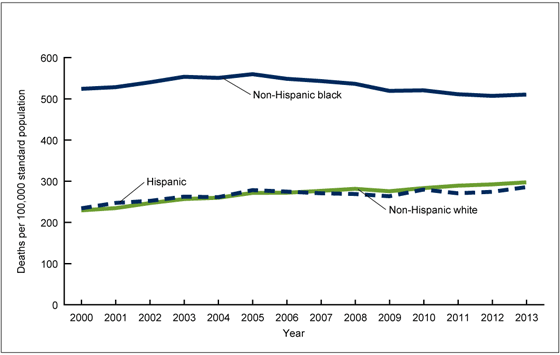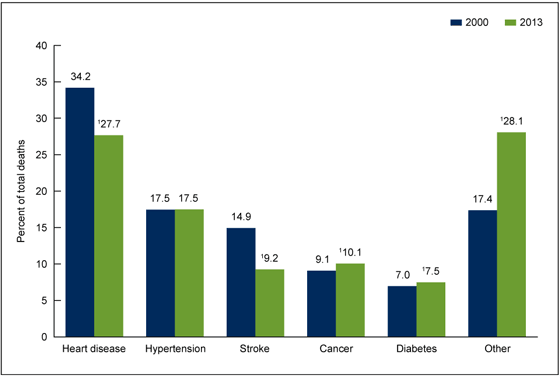Hypertension-related Mortality in the United States, 2000–2013
NCHS Data Brief No. 193, March 2015
On This Page
- Key findings
- The age-adjusted hypertension-related death rate increased 23.1%, whereas the rate for all other causes of death combined decreased 21.0% from 2000 through 2013.
- The hypertension-related death rate was higher for women than men aged 85 and over but was lower for women aged 45–64, 65–74, and 75–84 throughout the 2000–2013 period.
- From 2000 through 2013, the age-adjusted hypertension-related death rate was highest among the non-Hispanic black population compared with the non-Hispanic white and Hispanic populations.
- In 2000 and 2013, the top five underlying causes of hypertension-related death were heart disease, hypertension, stroke, cancer, and diabetes.
- Summary
- Definitions
- Data sources and methods
- About the authors
- References
- Suggested citation
PDF Version (568 KB)
Hsiang-Ching Kung, Ph.D., and Jiaquan Xu, M.D.
Key findings
- The age-adjusted hypertension-related death rate increased 23.1%, whereas the rate for all other causes combined decreased 21.0% from 2000 through 2013.
- Rates for hypertension-related death increased for both sexes aged 45–64 and 85 and over from 2000 through 2013.
- The age-adjusted hypertension-related death rate increased for all Hispanic origin and race groups examined from 2000 through 2005. Since then, the rate for the non-Hispanic white population continued to increase, whereas the rate for the non-Hispanic black population decreased.
- Although the age-adjusted hypertension-related death rate for the non-Hispanic black population was higher than for the non-Hispanic white and Hispanic populations throughout the period, the gap between them narrowed.
Hypertension is a chronic condition that can lead to heart disease, stroke, and other diseases that can result in premature death. Reducing the number of persons in the population with hypertension is one of the objectives of Healthy People 2020 (1). Using national multiple cause-of-death data files from the National Vital Statistics System, this report presents trends in hypertension-related mortality for 2000–2013 by selected demographic characteristics and the underlying causes of hypertension-related death. Hypertension-related mortality is defined by any mention of hypertension on the death certificate. Because about 2% of all decedents with hypertension reported on the death certificate were under age 45, only decedents aged 45 and over were included in this analysis.
Keywords: high blood pressure, death rate, National Vital Statistics System
The age-adjusted hypertension-related death rate increased 23.1%, whereas the rate for all other causes of death combined decreased 21.0% from 2000 through 2013.
Figure 1. Number of deaths and age-adjusted death rates for hypertension-related and all other causes of death combined: United States, 2000–2013
1Linear decrease from 2000 to 2013 is statistically significant at p < 0.05 level.
2Linear increase from 2000 to 2013 is statistically significant at p < 0.05 level.
NOTES: Hypertension-related deaths are identified using ICD–10 codes I10, I11, I12, I13, and I15 for underlying and contributing causes of death, according to the International Classification of Diseases, 10th revision (ICD–10). Rates are age-adjusted. Access data table for Figure 1.
SOURCE: CDC/NCHS, National Vital Statistics System, Mortality.
- The number of hypertension-related deaths increased 61.8%, from 245,220 in 2000 to 396,675 in 2013. Overall, the number of deaths from all other causes of death combined increased 3.5% during the same period (Figure 1).
- The age-adjusted hypertension-related death rate increased 23.1%, from 255.1 per 100,000 population in 2000 to 314.1 in 2013, whereas the rate for all other causes of death combined decreased 21.0%, from 2,032.7 in 2000 to 1,605.9 in 2013.
- The proportion of all decedents aged 45 and over with any mention of hypertension on the death certificate increased steadily from 11.1% in 2000 to 16.4% in 2013.
The hypertension-related death rate was higher for women than men aged 85 and over but was lower for women aged 45–64, 65–74, and 75–84 throughout the 2000–2013 period.
- For women aged 85 and over, the hypertension-related death rate increased 23%, from 2,003.1 per 100,000 population in 2000 to 2,464.4 in 2005, and it increased 27.5% for men, from 1,654.8 in 2000 to 2,110.4 in 2005 (Figure 2). The rates for both women and men continued to increase through 2013 but at a much slower pace.
- Among persons aged 75–84, the rate for women increased 10.9% from 2000 through 2005, and then changed from 692.3 in 2006 to 689.7 per 100,000 population in 2013. The rate increased 15.3% for men from 2000 through 2005 and continued to increase slightly, by 6.2% by 2013.
- From 2000 through 2013, the death rate increased 16.5% for men aged 65–74. Rates increased 58.2% for men and 36.8% for women aged 45–64.
Figure 2. Hypertension-related death rates, by sex and selected age group: United States, 2000–2013
NOTES: Linear increases from 2000 through 2013 for all male age groups and women aged 45–64 and 85 and over are statistically significant at the p < 0.05 level. Hypertension-related deaths are identified using ICD–10 codes I10, I11, I12, I13, and I15, according to the International Classification of Diseases, 10th revision (ICD–10). Access data table for Figure 2 [PDF - 123KB].
SOURCE: CDC/NCHS, National Vital Statistics System, Mortality.
From 2000 through 2013, the age-adjusted hypertension-related death rate was highest among the non-Hispanic black population compared with the non-Hispanic white and Hispanic populations.
- From 2000 through 2013, the age-adjusted hypertension-related death rate increased for the non-Hispanic white population. For the non-Hispanic black and Hispanic populations, the rate increased from 2000 through 2005; since then, it decreased for non-Hispanic black persons and fluctuated for Hispanic population (Figure 3).
- For the non-Hispanic black population, the rate increased 6.8% from 523.8 per 100,000 population in 2000 to 559.3 in 2005, and then it decreased 8.8% to 509.9 in 2013. For the Hispanic population, the rate increased 18.9% from 233.7 in 2000 to 277.9 in 2005, decreased 5.4% to 262.9 in 2009, and then increased 8.3% to 284.8 in 2013. For the non-Hispanic white population, the rate increased 29.8% from 228.5 in 2000 to 296.5 in 2013.
- Although the age-adjusted hypertension-related death rate for the non-Hispanic black population was consistently higher than that for non-Hispanic white and Hispanic populations throughout the period, the gap between them narrowed.
Figure 3. Age-adjusted hypertension-related death rates, by race and Hispanic origin: United States, 2000–2013
NOTES: Linear increases for the non-Hispanic white population from 2000 through 2013 and for the Hispanic and non-Hispanic black populations from 2000 through 2005 are statistically significant at the p < 0.05 level. Linear decreases for the non-Hispanic black population from 2005 to 2013 and for the Hispanic population from 2005 to 2009 are statistically significant at the p < 0.05 level. Hypertension-related deaths are identified using ICD–10 codes I10, I11, I12, I13, and I15 for underlying and contributing causes of death, according to the International Classification of Diseases, 10th revision (ICD–10). Access data table for Figure 3 [PDF - 123KB].
SOURCE: CDC/NCHS, National Vital Statistics System, Mortality.
In 2000 and 2013, the top five underlying causes of hypertension-related death were heart disease, hypertension, stroke, cancer, and diabetes.
- Hypertension was selected as the underlying cause of death in one out of six hypertension-related deaths in 2000 and 2013 (Figure 4). In the remaining 83%, another underlying cause of death was selected.
- Heart disease, stroke, cancer, and diabetes accounted for 65% of all deaths with any mention of hypertension in 2000, and for 54% in 2013.
- Between 2000 and 2013, the proportion of all hypertension-related deaths that had heart disease as the underlying cause of death decreased from 34.2% to 27.7%, and the proportion that had stroke as the underlying cause of death decreased from 14.9% to 9.2%.
Figure 4. Distribution of the underlying causes of hypertension-related death: United States, 2000 and 2013
1Significantly different from year 2000 at the p < 0.01 level.
NOTE: The causes were coded for Heart disease as I00–I09 and I20–I51, Hypertension as I10–I15, Cancer as C00–C97, Stroke as I60–I69, and Diabetes as E10–E14, based on the International Classification of Diseases, 10th revision.
SOURCE: CDC/NCHS, National Vital Statistics System, Mortality.
Summary
This report reveals a continued rise in the hypertension-related death rate during the 2000–2013 period, following the increase that occurred during the 1980–1998 period (2). The increasing trend was seen in both women and men aged 45–65 and 85 and over. The rate was the highest for those aged 85 and over, followed by those aged 65–84 and 45–64.
After an upward trend from 2000 through 2005, the age-adjusted hypertension-related death rate decreased about 9% for the non-Hispanic black population by 2013. On the other hand, rates for the non-Hispanic white population increased steadily throughout the period. As a result, the difference in rates between the non-Hispanic white population and the non-Hispanic black population narrowed during the period, even though the rate among non-Hispanic black persons continued to be highest.
The proportion of all decedents with any mention of hypertension on the death certificate where the underlying causes of death were heart disease and stroke (first- and third-leading underlying causes of hypertension-related death) decreased 19% and 38%, respectively, between 2000 and 2013.
This report shows that about one out of six hypertension-related deaths had hypertension as the underlying cause of death, and the rest had hypertension as a contributing cause of death for other underlying causes. Using multiple cause-of-death data, this report provides a comprehensive picture of the burden of hypertension-related mortality in the United States from 2000 through 2013.
Definitions
Cause-of-death classification: Refers to medical information—including injury diagnoses and external causes of injury—entered on death certificates filed in the United States that is classified and coded in accordance with the International Statistical Classification of Diseases and Related Health Problems, 10th Revision (ICD–10) (3).
Underlying cause of death: Defined by the World Health Organization as “the disease or injury which initiated the train of events leading directly to death, or the circumstances of the accident or violence which produce the fatal injury” (3). The underlying cause of death is selected from the condition entered by the medical certifier in the cause-of-death section of the death certificate. The number of deaths due to underlying causes is ranked among all hypertension-related deaths to select the top five causes. See the Technical Notes of “Deaths: Final Data for 2010” (4) for more detail.
Hypertension-related death: Defined as a death with hypertension reported (any mention of hypertension) on the death certificate, including essential hypertension (ICD–10 code I10), hypertensive heart disease (I11), hypertensive renal disease (I12), hypertensive heart and renal disease (I13), and secondary hypertension (I15).
Data sources and methods
Data presented in this report reflect information collected on death certificates filed by the 50 states and the District of Columbia in the United States. Data are from the public-use multiple cause-of-death files from the National Vital Statistics System from 2000 through 2013 (5). Death rates are based on the enumerated population as of April 1, 2000, and April 1, 2010, intercensal population estimates as of July 1, 2001–2009, and postcensal population estimates as of July 1, 2011–2013 that are consistent with the April 1, 2000, and April 1, 2010, census (6). The direct standardization method was used to calculate age-adjusted death rates. Rates are based on the projected year 2000 standard population (7). The significance of trends was tested using the Joinpoint regression program at α = 0.05 level (8). Differences between percentages were evaluated using a two-tailed z test at the 0.01 level.
About the authors
Hsiang-Ching Kung and Jiaquan Xu are with CDC’s National Center for Health Statistics, Division of Vital Statistics, Mortality Statistics Branch.
References
- HHS. Healthy People 2020.
- Ayala C, Croft JB, Wattigney WA, Mensah GA. Trends in hypertension-related death in the United States: 1980–1998. J Clin Hypertens 6(12):675–81. 2004.
- WHO. International statistical classification of diseases and related health problems, 10th revision (ICD–10). 2nd ed. Geneva, Switzerland. 2004.
- Murphy SL, Xu JQ, Kochanek KD. Deaths: Final data for 2010. National vital statistics reports; vol 61 no 4. Hyattsville, MD: National Center for Health Statistics. 2013.
- NCHS. Vital statistics data available online. Mortality multiple cause files.
- NCHS. U.S. census populations with bridged race categories.
- Anderson RN, Rosenberg HM. Age standardization of death rates: Implementation of the year 2000 standard. National vital statistics report; vol 47 no 3. Hyattsville, MD: National Center for Health Statistics. 1998.
- National Cancer Institute. Joinpoint Regression Program (Version 4.1.1.) [computer software]. 2014.
Suggested citation
Kung HC, Xu JQ. Hypertension-related mortality in the United States, 2000–2013. NCHS data brief, no 193. Hyattsville, MD: National Center for Health Statistics. 2015.
Copyright information
All material appearing in this report is in the public domain and may be reproduced or copied without permission; citation as to source, however, is appreciated.
National Center for Health Statistics
Charles J. Rothwell, M.S., M.B.A., Director
Nathaniel Schenker, Ph.D., Deputy Director
Jennifer H. Madans, Ph.D., Associate Director for Science
Division of Vital Statistics
Delton Atkinson, M.P.H., M.P.H., P.M.P., Director
- Page last reviewed: November 6, 2015
- Page last updated: March 26, 2015
- Content source:


 ShareCompartir
ShareCompartir



